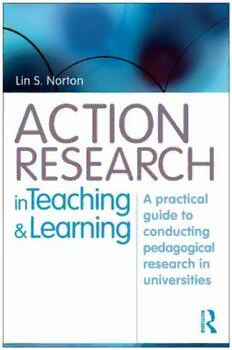Table Of ContentAction Research in Teaching and Learning
A practical, down-to-earth guide for those who work in teaching and learn-
ing in universities, this book will be indispensable reading for those who
would like to carry out action research on their own practice. Lin S. Norton’s
concept of ‘pedagogical action research’ has come from over twenty years’
experience of carrying out such research, and more than six years of
encouraging colleagues to carry out small-scale studies at an institutional,
national and international level.
This accessible text illustrates what might be done to improve teaching/
supporting learning by carrying out action research to address such questions
such as:
(cid:1) What can I do to enthuse my students?
(cid:1) What can I do to help students become more analytical?
(cid:1) How can I help students to link theory with their practice?
(cid:1) What can I do to make my lecturing style more accessible?
(cid:1) What is going wrong in my seminars when my students don’t speak?
Action Research in Teaching and Learning offers readers practical advice on
how to research their own practice in a higher-education context. It has been
written specifically to take the reader through each stage of the action
research process with the ultimate goal of producing a research study which
is publishable. Cognisant of the sector’s view on what is perceived to be
‘mainstream research’, the author has also written a substantial theoretical
section which justifies the place of pedagogical action research in relation to
reflective practice and the scholarship of teaching and learning.
Lin S. Norton is Professor of Pedagogical Research and Dean of Learning
and Teaching at Liverpool Hope University. She was awarded a National
Teaching Fellowship in 2007 and continues to champion the importance of
learning and teaching by extensively publishing in journals and books.
Action Research in Teaching
and Learning
A practical guide to conducting pedagogical
research in universities
Lin S. Norton
Firstpublished2009
byRoutledge
2 Park Square, Milton Park, Abingdon, Oxon OX14 4RN
SimultaneouslypublishedintheUSAandCanada
byRoutledge
29West35thStreet,NewYork,NY10001
RoutledgeisanimprintoftheTaylor&FrancisGroup,aninformabusiness
This edition published in the Taylor & Francis e-Library, 2009.
To purchase your own copy of this or any of Taylor & Francis or Routledge’s
collection of thousands of eBooks please go to www.eBookstore.tandf.co.uk.
©2009LinS.Norton
All rights reserved. No part of this book may be reprinted or reproduced or
utilisedinanyformorbyanyelectronic,mechanical,orothermeans,now
knownorhereafterinvented,includingphotocopyingandrecording,orinany
informationstorageorretrievalsystem,withoutpermissioninwritingfrom
thepublishers.
BritishLibraryCataloguinginPublicationData
A catalogue record for this book is available from the British Library
LibraryofCongressCataloginginPublicationData
Acatalogrecordforthisbookhasbeenrequested
ISBN 0-203-87043-3 Master e-book ISBN
ISBN13:978-0-415-46846-6(hbk)
ISBN13:978-0-415-43794-3(pbk)
To the three most important people in my life:
Bill, Chris and Heather. Thank you for everything.
Contents
List of figures ix
List of tables xi
Acknowledgements xii
Foreword xiii
Preface xv
1 Putting pedagogical action research into the university context:
what are the pressures? 1
2 Why be a reflective practitioner? 21
3 Why engage with the scholarship of teaching and learning? 36
4 What is the case for pedagogical action research? 50
5 Where do you start a pedagogical action research study? 69
6 What are the most suitable research methodologies? 87
7 Howcanyouanalysequalitativedatainpedagogical
actionresearch? 115
8 Howcanyouanalysequantitativedatainpedagogical
actionresearch? 131
9 How can you develop and adapt pedagogical research tools? 155
10 What are the ethical issues involved in pedagogical
action research? 179
11 Going public: How can you grow the influence of your findings? 194
viii Contents
Appendix A Some suggested methods of reflecting on practice 220
Appendix B An example of a research protocol taken from the Write
Now CETL research programme 223
Appendix C Case study showing how qualitative and quantative
data can be combined 228
Appendix D Exploring ways of measuring conceptions of learning 230
Appendix E An example of a completed participant information sheet 232
Appendix F Consent form template 235
Appendix G Case study of a pedagogical action research study to
illustrate some ethical issues 236
Appendix H Ethics submission template 239
Appendix I Example of an unsuccessful abstract that was submitted
to a conference as a research paper 241
Appendix J Example of a successful abstract that was submitted to a
conference as a research paper 243
Appendix K Example of a letter to the editor of a journal accompanying
a rewritten manuscript 244
Appendix L Example of a response to reviewers’ comments 246
Appendix M Example of a budget for an internally funded research bid 248
Bibliography 250
Index 261
fi
List of gures
1.1 Representation of Neumann, Parry and Becher’s (2002)
description of disciplines 12
5.1 Bar chart showing average number of journals used in
assignments in three psychology courses 81
5.2 Bar chart showing average number of journals used in
assignments of two cohorts of counselling psychology students 81
5.3 Bar chart showing average number of journals used in
assignments of two cohorts of crime psychology students 83
5.4 Bar chart showing average number of journals used by crime
psychology students who also took counselling psychology 83
6.1 Decison chart for deciding on an appropriate research method 92
6.2 Scattergram showing a positive correlation between number of
lectures attended and coursework marks 110
6.3 Scattergram showing a negative correlation between average
number of weekly hours socialising and exam marks 111
6.4 Scattergram showing no correlation between number of
seminars attended and exam marks 112
8.1 Bar chart showing frequency count in response to the
questionnaire item ‘We are expected to learn the topics
ourselves’ 139
8.2 Pie chart showing frequency count in response to the
questionnaire item ‘We are expected to learn the topics
ourselves’ 140
9.1 An example of the ideal self inventory 156
9.2 An example of a completed ideal lecture inventory 157
9.3 An example of a learning objectives questionnaire on seminars 161
9.4 The module assessment questionnaire (adapted from Steward,
Norton, Evans and Norton, 2003) 166
9.5 Hypothetical example of a RoLI© profile for ‘Suzy’ 168
9.6 Säljö’s (1979) hierarchical conceptions of learning 170

